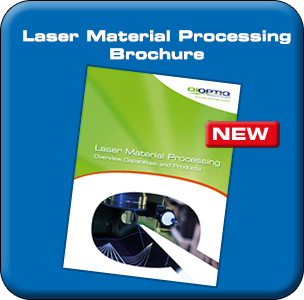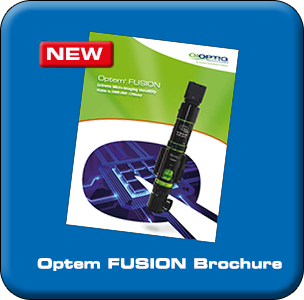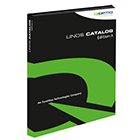- Optomechanik
- Präzisionsoptik
- Optik Software
- Lichtquellen & Laser
- Neue Produkte
FAQ zu Laser Modulatoren

Frequently Asked Questions on Laser Modulators (FAQ)
1. What is the difference between intensity, phase and universal modulators?
There are three types of Laser Modulators:
a) Intensity Modulator (P) - Modulates intensity (Power P) respective to the amplitude of polarized laser light. The Intensity modulator (P) changes the intensity respective to the amplitude of the laser light. An intensity modulator is an universal laser modulator which includes an output polarizer.
b) Phase Modulator (PHAS) – Modulates phase of polarized laser light. The Phase modulator (PHAS) changes the phase of linear polarized laser light. This means the linear polarized light traveling through the phase modulator will pass it slower if a voltage is applied (phase shift of half wave or half period if half wave voltage is applied).
c) Universal Modulator - Modulates polarization state of polarized laser light or modulates phase of laser light. The Universal Modulator can be used in three different operation modes:
1) The Universal Modulator is changing the polarization state of the linear polarized light from keeping it linear (no voltage is applied) to circular (quarter wave voltage is applied) to linear but 90° rotated (half wave voltage is applied). If the customer is adding his own polarizer after the laser modulator output then this set (universal laser modulator + polarizer) is changing the intensity of the laser light, so it acts as an intensity modulator.
2) If a quarter-wave plate is positioned at the output of the universal modulator, then the polarization plane of the linear polarized light can be rotated continuously depending on the applied voltage.
3) An Universal Modulator can also change the phase of linear polarized laser light if used in a different orientation, please refer to the LM13 and LM0202 Laser Modulator manual.
An Universal Modulator can be used for both polarization and phase modulation, however phase modulation using an Universal Modulator requires a doubled-switching voltage compared to a pure phase modulator respectively compared if the Universal Modulator is used as polarization modulator.
2. Which Laser Modulator do I need for amplitude (intensity) modulation?
For amplitude (intensity) modulation, you can use either an Universal Modulator [1. c)] or an Intensity Modulator (P) [1. a)]. To use an Universal Modulator for amplitude (intensity) modulation, you will need to add your own polarizer. The Intensity Modulator (P) is already equipped with a suited polarizer.
3. Which Laser Modulator do I need for modulation of polarization state or rotation of linear polarization?
a) For modulation of polarization state (from linear via elliptical to
circular and back to linear but 90° rotated), you should use an Universal
Modulator [1. c)].
b) For rotation of linear polarization, you should use an Universal
Modulator [1. c)] and
an additional quarter-wave plate positioned after the Universal Modulator [1. c)].
4. Which Laser Modulator do I need for phase modulation?
For phase modulation, you can use the Phase Modulator (PHAS) [1. b)] or an Universal Modulator [1. c)]. Please note: If an Universal Modulator is used for phase modulation it will require double switching voltage compared to a pure phase modulator or what is specified for half-wave voltage of the Universal Modulator, i.e. for half-wave phase shift a 2-times larger half-wave voltage is required.
5. What is the switching voltage at a specific wavelength?
The switching voltage (e.g. quarter- or half-wave switching voltage) is approximately linear proportional to the used laser wavelength. The quarter-wave switching voltage is 50% of the half-wave switching voltage. We specify half-wave switching voltage of our laser modulators (LM0202 series) at the typical wavelength of the laser modulator type:
· at 355nm for UV modulators – 120V for Ø1.5mm aperture* / 200V for Ø3.5mm aperture*
· at 633nm for visible modulators - 210V for 3x3mm² aperture / 350V for 5x5mm²aperture
· at 1064 for infrared modulators - 360V for 3x3mm² aperture / 590V for 5x5mm²aperture
* For some Laser Modulator models (e.g. UV or High-Power versions) the round aperture diameter is smaller than the square crystal aperture due to a circular aperture stop.
6. How can I calculate the switching voltage for a specific wavelength?
The switching voltage (e.g. quarter- or half-wave switching voltage) is almost linear proportional to the used laser wavelength. We specify half-wave switching voltage of our laser modulators at a typical wavelength. This can be used to calculate the switching voltage at the wavelength of your application. Let us take U1 = 210V for 3x3mm² aperture at l1 = 633nm for visible modulators. The switching voltage U2 for a second wavelength l2will be:
U1/l1= U2/l2 U2 = l2* U1/l1
Example, if the wavelength of your application is l2= 800nm, then the switching voltage U2 will be: U2= 800nm * 210V/633nm = 265V
7. Do Laser Modulators show Piezo-ringing?
Piezo-ringing effect is low for LINOS Laser Modulators because of the use of transversal electrical fields and relatively low voltages compared to Pockels Cells. An operation with a sinusoidal waveform will show a weaker piezo ringing compared to pulse operation, which has steep switching edges. See also question [13].
8. Drivers for Laser Modulators
Laser Modulators require a fairly high voltage to achieve half-wave voltage modulation or switching. Please find below a selection of suppliers of various high voltage drivers for Laser Modulators. There are two general options to operate a Laser Modulator:
· digital or pulse modulation (similar to on/off-modulation or on/off-switching) and
· continuous analogue modulation (applying an analogue waveform to the modulator).
a) Drivers for pulses, on/off-switching or digital modulation - Pockels Cell drivers and pulse amplifiers:
Qioptiq DIV20 digital pulse amplifier – best suited for most of our Laser Modulators: http://www.qioptiq-shop.com/en/Precision-Optics/LINOS-Laser-Modulators-Pockels-Cells/LINOS- Laser-Modulators/Digital-Pulse-Amplifier-DIV-20.html
Behlke – Set of high voltage switches and power supplies: http://www.behlke.com/separations/separation_d.htm
Kentech: http://kentech.co.uk/index.html?/pock_cell_drivers.html&2 Adamietz: https://www.elektronik-adamietz.de/produkte/pockels-cell-driver/ RPMC: https://www.rpmclasers.com/types/pockels-cell-driver/
Piezo Drive (piezo driver): https://www.piezodrive.com/drivers/ OEM-Tech: https://www.oem-tech.by/catalog/embedded-pcd/
b) Drivers for analogue modulation (we don’t offer analogue voltage amplifiers):
Analogue Voltage Amplifier suppliers: http://www.trekinc.com/products/products_m.asp http://www.matsusada.com/product/
High Voltage Amplifier Distributor http://www.hivolt.de/index.php?id=hvamplifiers&L=1
9. Which pulse frequencies are supported by the DIV20 Pulse amplifier?
Please refer to Fig. 2 (page 9) of the DIV20 manual, which showcases which maximum voltage the DIV20 driver is supporting up to what frequency. Typical maximum voltage values are:
· ≤590 V up to 1 MHz
· ≤500 V up to 2 MHz
· ≤300 V up to 5 MHz
· ≤100 V up to 15 MHz
As an example, the DIV20 will not support switching voltage of ≥300 V for frequencies above 5 MHz. Please take the maximum half-wave voltage of the Laser Modulator into account.
For example, a LM0202 with 3x3 mm² aperture used at 815 nm has a half wave voltage of 270 V ±10%. Due to this, a maximum switching voltage of 300 V should be taken into account.
10. Which function or waveform generator do I need to trigger the DIV20 Pulseamplifier?
For most applications, a standard function or waveform generator with 0 – 5V output (to generate the TTL signal) and pulse frequency of typical 10 MHz or more should be suitable (maximum frequency should be according to the required maximum pulse frequency).
The function (or signal or waveform) generator can be a PC card (typically PCIe card) or an external stand-alone device. Usually DAC cards (AD/DA data acquisition cards) have simple TTL signal outputs (or configurable 5V analogue voltage outputs), which can be used so long as they support the required switching frequency.
If you want to generate random pulses, an arbitrary waveform generator is required (the configurable analogue output of a DAC card might be also able to support this, but please check supported frequency).
The choice of function or waveform generators is huge, just a few examples: https://www.digikey.com/en/products/filter/equipment-function- generators/630?s=N4IgTCBcDaIO4EMBuBTAZgewE4FsAEA5igHYpYIAu2IAugL5A https://uk.farnell.com/c/test-measurement/signal-generators-counters/arbitrary-function-pulse- generators
https://www.ni.com/de-de/shop/hardware/products/pxi-waveform-generator.html
11. Can I use a Pockels Cell instead of a Laser Modulator?
In general Pockels Cells can be used for continuous modulation of amplitude or polarization state of laser light. However, Pockels Cells usually have a pretty high (several kV) switching voltage. This will make the driver expensive if one needs continuous modulation of amplitude or polarization state. Pockels Cells are usually used as Q-Switches, Pulse Slicers or Pulse Pickers. Pockels Cells are not designed for phase shift.
12. What is the difference between LM13 and LM0202 series?
The LINOS LM0202 Modulator series is equipped with 4 crystals in a line (capacitance is typically
C = 82pF) whereas our LM13 modulator series is equipped with 2 crystals in a line. The LM13 series has a capacity of typically C = 46pF only, but needs twice the switching voltage compared to a LM0202 modulator.
The LINOS LM13 modulator series is shorter compared to the LM0202 modulator series. It might be better suited if the available free space is limited.
13. What is the difference between ADP and KD*P – based laser modulators?
ADP (Ammonium Dihydrogen Phosphate) and KD*P (Deuterated Potassium Phosphate) are both electro- optical crystals. ADP has less and weaker piezo ringing, but stronger temperature dependent change of switching voltage compared to KD*P.
14. What is extinction ratio and how is it measured?
Extinction ratio (ER) is the ratio of optical power at maximum (applied voltage is 0V or contacts are electrically grounded) and minimum (applied voltage is the half-wave voltage) transmission (Tmax and Tmin). Extinction ratio is measured with the laser modulator placed between a linear polarized continuous wave laser as input and a parallel polarizer at the output (orientation is parallel to the linear polarized laser beam).
ER = Tmax/Tmin
15. Do you offer resonant circuit laser modulators?
All of our standard modulators are broadband. We can offer a separate SINE-Amplifier that can be used to form a resonance circuit with our modulators (especially with our Phase Modulator PM-C-BB). The most common application is sideband-generation.
16. How do I choose the best suited laser modulator for my application?
Please take into account the following parameters of your system, including the high voltage driver:
a) Type of modulator: You can choose a phase, intensity or universal laser modulator. Please refer to questions 1 to 4 for more details.
b) Wavelength: We offer laser modulators that operate in the UV (300-390 nm), visible (400-850 nm) and infrared (650-1000 nm, 700-950 nm or 950-1100 nm) wavelength ranges.
c) Power capability: Depending on your chosen wavelength, we offer laser power capabilities from 0.1 W up to 20 W.
d) Aperture: Depending on your laser beam size, you can choose either a 3x3 mm² or 5x5 mm² aperture modulator. Some UV and high-power modulators have a round Ø 1 mm and Ø 3 mm aperture stop.
e) Laser beam diameter: The laser beam diameter should be at least by a factor of 2.5 smaller compared to the aperture diameter. Hence for a 3x3 mm² aperture the maximum beam diameter is d1/e² ≤ 1.2 mm and for a 5x5 mm² aperture it is d1/e² ≤ 2.0 mm. Use of larger beam diameters is possible but will cause beam clipping.
f) Half-wave voltage requirements: Approximate the required operation voltage for your laser modulator according to questions 5 and 6, and make sure your high voltage driver is capable of delivering such voltage at the required modulation frequency. Please note, the maximum voltage should not exceed 800V.
g) Modulation requirements: Ensure the modulation frequencies you need are supported by the laser modulator (<100 MHz at 3 dB, the 3 dB limit is a modulation depth of only 50% at 100 MHz) and the high voltage driver. If you are using the DIV20 pulse amplifier, refer to question 9.
h) Space requirements: If you need a compact laser modular (at the expense of a larger half-wave switching voltage), refer to our LM13 series. If you need a laser modulator with a lower half-wave voltage, refer to our LM0202 series. See question 12 for more details.
i) Other considerations: Extinction (see question 0), transmission (refer to the laser modulator specification), piezo-ringing effects (see question 7), rise/fall time, etc.
17. How do I choose a suited driver?
Important performance parameters for the Laser Modulator driver are:
· Whether digital pulse modulation (similar to on/off-modulation or on/off-switching) and/or continuous analogue modulation are required (see question8)
· Maximum high voltage (please check required maximum voltage, see questions 5 and 6)
· Modulation- or pulse-frequency bandwidth and maximum supported frequency
· Rise- and fall time (refer to the laser modulator and driver specification)
· Maximum capacitance load of the driver (LM13 has a typical capacitance of C = 46pF and LM0202 has C = 82pF)
18. Can I use a Laser Modulator to rotate the polarization plane of linear polarized light?
An Universal Modulator is suited to rotate the polarization plane of the linear polarized light (see question 1). If a quarter wave plate is positioned at the output of the universal modulator, then the polarization plane of the linear polarized light can be rotated continuously depending on the applied voltage.
19. Can I use a Laser Modulator to switch on/off laser intensity slow or fast?
Either an Intensity Modulator or an Universal Modulator is suited to switch on/off laser intensity slow or fast with frequencies up to MHz range and rise times of < 30ns (see question 1).
20. Can I use a Laser Modulator to continuous modulate laser intensity?
Either an Intensity Modulator or an Universal Modulator is suited for continuous modulation of laser intensity with frequencies up to MHz range and rise times of < 30ns (see question 1).
21. Can I use a Laser Modulator for phase stabilization?
Yes, a Phase Modulator is suited for phase stabilization of interferometric or holographic setups. The voltage applied to the Phase Modulator needs to be controlled by a PID amplifier circuit depending on the feedback signal.
22. Do I need to adjust the Laser Modulator in relation to the laser beam?
Yes, it is necessary to adjust the laser modulator input & output apertures (hence the optical axis) in relation to the laser beam position to achieve the highest transmission and extinction. Also the offset voltage can be reduced or increased by adjustment of the laser modulator.
Lateral and angular adjustment of the laser modulator position is important to optimize optical axis and aperture positions of the laser modulator in the best way in relation to the laser beam to ensure the highest transmission and extinction.
23. How can I mount the Laser Modulator?
We recommend using two “Adjustable holder 55 – M” (part number G035904000) from our LINOS catalogue. This enables proper mounting as well as lateral and angular adjustment of the laser modulator.
Any other mounting concept may be also suitable so long as it enables lateral and angular adjustment of the laser modulator. It is also possible to use a fixed mount of the laser modulator if the laser beam can be lateral and angular adjusted in relation to the input and output apertures of the laser modulator. This can usually be achieved by using two adjustable mirrors.
Lateral and angular adjustment of the laser modulator position is important to optimize the optical axis and aperture positions of the laser modulator in the best way in relation to the laser beam to ensure the highest transmission and extinction.
24. Which precautions can I take to ensure long life time of my Laser Modulator?
When a modulator is not used for a longer time (e.g. not used overnight), please make sure that no voltage is applied.
Please do not store the Laser Modulator upright. Most of our Laser Modulators are filled with an optical immersion liquid. There is a risk of forming small air bubbles between the windows and the crystals in case the Laser Modulator is stored upright.
Please do not install the Laser Modulator in your setup in upright position for the same reason.







 Katalog anfordern
Katalog anfordern